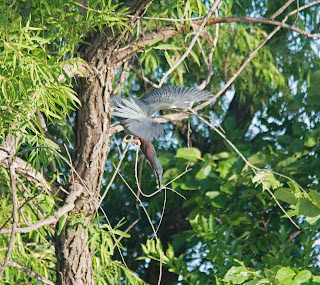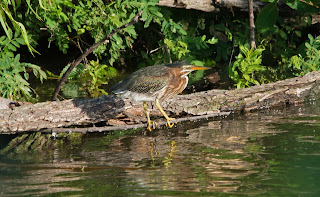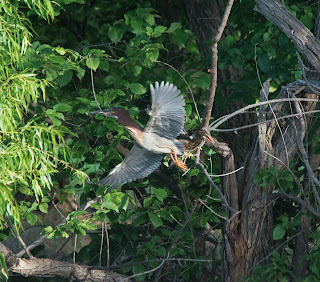Green Heron Fledgling
Face-off Between Adult and Fledgling
Green Heron Adult (rear) with Fledgling
(front)
Smooth Arrival
Green Heron Adult Between Trees 2 and 3
Leaving the Perch
Green Heron Adult Taking Off
Green Heron adult building nest
Diamond-backed Watersnake
Diamond-backed Watersnake (L) with Fledgling
Green Heron

Looking For That Big Snake!
Green Heron Clutch 2 Tree 3
I know dad's coming!
Yelling for dad
Dad's gone!
06-28-18
0700-0831/81-84 F/clear/S-11/69-68% RH/29.95-29.97 Hg and steady/SSE-6 to S-9
By the time 0800, rolled around, the Cove was a hotbed of pure activity. There were two
older fledglings in attendance (as well as an easy four foot diamond-backed watersnake).
The older fledge was eyeing this good-sized reptile, then went looking for it when it rolled
off its log into the water.
There were a couple of subadults that come in for baby care, which prepares them for their
own young in their third year. They have been tending to the fledglings by teaching them
hunting skills and how to be successful in survival.
Only three adults have been observed, but one nest was just made in tree 2. The sires came
from trees one and three, but I expect at least one or two more clutches afterward.
As noted earlier, both older fledges are very flighted, as they had to be in order to get to land.
It was a rough year after breeding last year with several god storms, which brought down limbs
and branches that were used for egress. Now that those are gone, nest and tree time is much longer.
Older young birds still expect the adults to feed them, but the adults don't play around with that
mentality long. They want their young to be earning their keep as quickly as possible so they can
raise more young.
Today, one of the adults led the younger bird (clutch 2) on a flying chase. Oddly, after that workout the little one disappeared, likely going to sleep. They don't possess a great deal of endurance at
that age, but in a week, they will be a lot stronger and more able to care for themselves and even younger birds.





















































